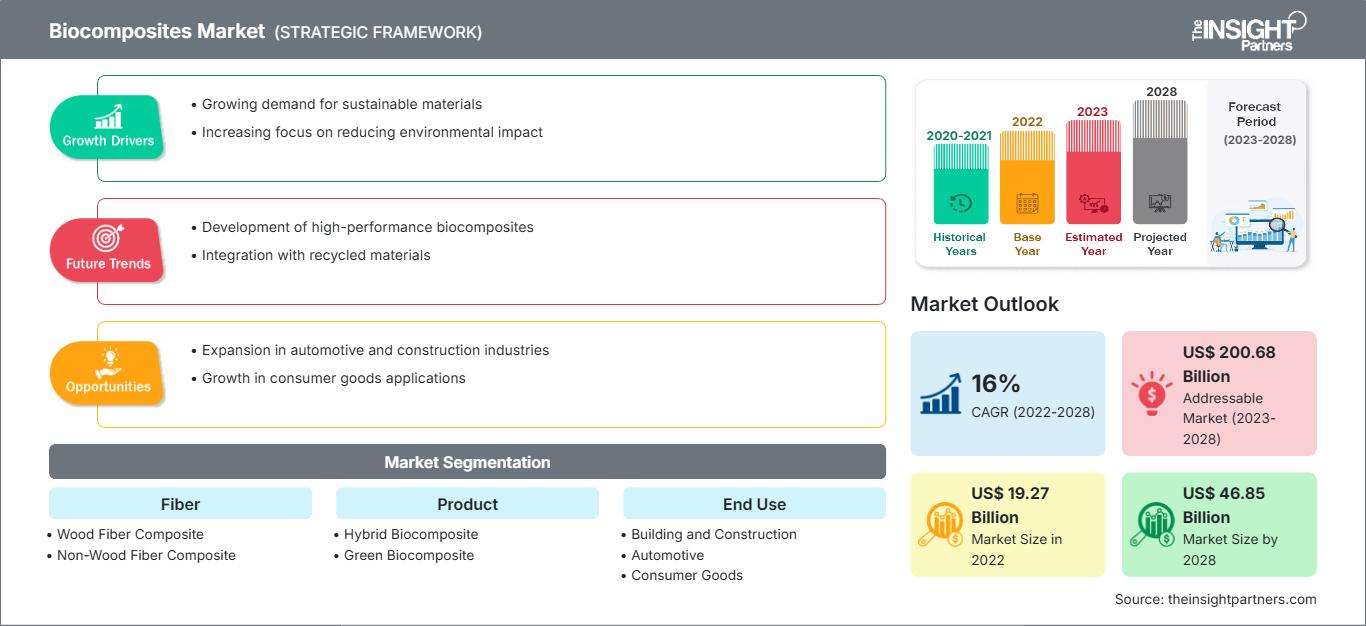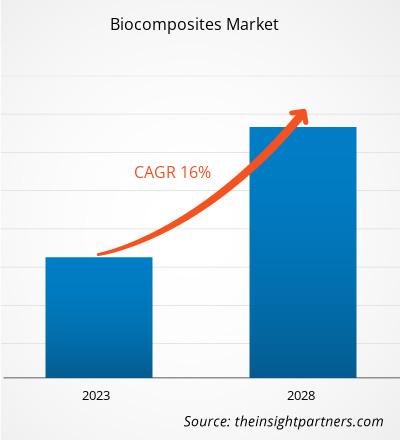[調査レポート] バイオ複合材料市場は、2022年の192億6,862万米ドルから2028年には468億5,139万米ドルに成長すると予想されており、2022年から2028年にかけて16%のCAGRで成長すると予測されています。
市場分析
バイオ複合材料は、天然繊維とマトリックス(樹脂)を強化して形成される材料です。バイオ複合材料は、入手しやすさ、高い比強度、軽量、生分解性、リサイクル性、低コスト、再生可能性など、多くの潜在的な利点があるため、基礎研究、包装、建設、軍事用途、航空宇宙、鉄道車両、自動車などの用途として最終用途産業の間で急速に関心が高まっています。バイオ複合材料は、自動車業界で内装パネルの製造に広く使用されています。バイオ複合材料は環境に優しいため、さまざまな用途で高価なポリマー複合材料に取って代わりつつあります。
成長の原動力と課題
持続可能な建築材料の使用増加は、バイオ複合材料市場の成長を後押ししてきました。建設業界は、都市部の人口増加により、急速な都市化の中で最も堅調な新興セクターの1つです。この都市化により、建設業界は材料の最大の消費者となり、そのほとんどは再生不可能な資源です。世界建築建設同盟の報告書によると、建設セクターは環境に最も有害なセクターの1つです。この調査によると、建設セクターは、環境に分散される二酸化炭素排出量の39%、世界のエネルギー消費量の36%、原材料抽出の50%を占めています。排出は主に気候変動の原因であり、地球温度を上昇させます。従来の建設資材は、多くの資源とエネルギーを消費します。そのため、従来の建築材料が社会と環境の両方に影響を与える危険性に対する懸念と意識が高まっています。これらの問題に対処するため、建設業界では新しい材料と技術の開発が進められています。バイオ複合材料は、再生不可能な廃棄物の削減、原材料の使用量削減、化石燃料の消費量削減に役立つ持続可能な建築材料です。再生可能、リサイクル可能、生分解性の資源から作られ、構造部材および非構造部材として幅広い用途があるため、建設業界におけるバイオ複合材料の利用への関心は世界的に高まっています。しかし、天然繊維複合材料には、繊維とマトリックスの界面結合の悪さ、濡れ性の悪さ、吸水性など、いくつかの欠点があります。これらの課題は、最終製品の強度と性能に影響を与えます。バイオ複合材料の親水性は、周囲の水分を吸収する傾向があり、複合材料を膨張させます。これらの要因はすべて、予測期間中のバイオ複合材料市場の成長を阻害すると予想されます。
要件に合わせてレポートをカスタマイズ
レポートの一部、国レベルの分析、Excelデータパックなどを含め、スタートアップ&大学向けに特別オファーや割引もご利用いただけます(無償)
バイオコンポジット市場: 戦略的洞察

- このレポートの主要な市場動向を入手してください。この無料サンプルには、市場動向から見積もりや予測に至るまでのデータ分析が含まれます。
レポートの一部、国レベルの分析、Excelデータパックなどを含め、スタートアップ&大学向けに特別オファーや割引もご利用いただけます(無償)
バイオコンポジット市場: 戦略的洞察

- このレポートの主要な市場動向を入手してください。この無料サンプルには、市場動向から見積もりや予測に至るまでのデータ分析が含まれます。
レポートのセグメンテーションと範囲
「2028年までの世界のバイオコンポジット市場分析」は、世界のバイオコンポジット市場の動向と成長機会に重点を置いた、専門的かつ詳細な調査です。本レポートは、繊維、製品、最終用途、地域別の詳細な市場セグメンテーションに基づき、世界のバイオコンポジット市場の概要を提供することを目的としています。世界のバイオコンポジット市場は近年高い成長を遂げており、予測期間中もこの傾向が続くと予想されています。本レポートでは、世界のバイオコンポジットの消費量と主要地域および国における需要に関する主要な統計を提供しています。さらに、主要地域および国におけるバイオコンポジット市場のパフォーマンスに影響を与える様々な要因の定性的な評価も提供しています。また、バイオコンポジット市場の主要プレーヤーとその主要な戦略的展開に関する包括的な分析も含まれています。市場ダイナミクスに関する複数の分析も含まれており、主要な推進要因、市場トレンド、収益性の高いバイオ複合材料市場の機会を特定するのに役立ちます。これにより、主要な収益ポケットを特定するのに役立ちます。
さらに、エコシステム分析とポーターの5つの力の分析により、世界のバイオ複合材料市場の360度のビューが提供され、サプライチェーン全体と市場の成長に影響を与えるさまざまな要因を理解するのに役立ちます。
セグメント分析
世界のバイオ複合材料市場は、繊維、製品、最終用途に基づいてセグメント化されています。繊維に基づいて、バイオ複合材料市場は木質繊維複合材と非木質繊維複合材に分かれています。製品に基づいて、市場はハイブリッドバイオ複合材とグリーンバイオ複合材に分類されます。最終用途に基づいて、市場は建築および建設、自動車、消費財、その他に分類されます。
繊維ベースでは、木質繊維複合材セグメントがバイオコンポジット市場で大きなシェアを占めています。木質繊維複合材の主な欠点は湿気に弱いことですが、研究開発の増加に伴い、メーカーはより高い耐湿性、より高い剛性、より低い熱膨張係数を備えた木質繊維部品を生産しています。製品ベースでは、ハイブリッド複合材が最大の市場シェアでバイオコンポジット市場をリードしています。最終用途では、建築および建設セグメントがバイオコンポジット市場を支配しています。建物内のバイオコンポジットは、フレーム、壁や壁板、窓枠、ドア、床材、装飾パネル、キュービクルの壁、天井パネルに使用されます。バイオ複合材を一時的かつ調整可能な建築部品に使用すると、構造内の内部設計が変更された場合に埋め立て廃棄物が削減されます。
地域分析
このレポートでは、北米、ヨーロッパ、アジア太平洋 (APAC)、中東およびアフリカ (MEA)、南米および中米の5つの主要地域に関して、世界のバイオ複合材市場の詳細な概要を提供しています。アジア太平洋地域は市場の大きなシェアを占め、2022年には93億米ドルを超えると評価されています。アジア太平洋地域は、中国、インド、日本、韓国、オーストラリアなど、いくつかの発展途上国と先進国で構成されています。その成長に貢献している重要な要因は、最終用途産業向けの建築および輸送からの需要の増加です。バイオ複合材の需要が高いのは、主に中国、日本、インド、韓国です。また、運輸・インフラセクターへの外国直接投資(FDI)の増加も、今後数年間のバイオコンポジット需要を牽引すると予想されています。欧州でも、インフラ整備への政府支出の増加により、2028年には約110億米ドルという大幅な成長が見込まれています。さらに、北米では、住宅・商業施設、消費財、自動車セクターにおいてバイオコンポジットが広く利用されています。これにより、バイオコンポジット市場に大きなビジネスチャンスが生まれています。北米のバイオ複合材料市場は、予測期間中に15.0%のCAGRで成長すると予想されています。
業界の発展と将来の機会
パートナーシップ、買収、新製品の発売は、世界のバイオ複合材料市場で活動する企業が採用している主要な戦略であることがわかりました。
- 2022年5月、アルケマはリサイクル可能でこれまで以上に効率的な複合材料の新しいソリューションを発売する予定でした。
- 2021年3月、ファイバーオンは、木材の比類のない美しさと温かさと、高性能でメンテナンスの少ない材料の耐久性を兼ね備えたワイルドウッド複合材クラッディングの発売を発表しました。
バイオコンポジット市場の地域別分析
予測期間を通じてバイオコンポジット市場に影響を与える地域的な動向と要因については、The Insight Partnersのアナリストが詳細に解説しています。このセクションでは、北米、ヨーロッパ、アジア太平洋、中東・アフリカ、中南米におけるバイオコンポジット市場のセグメントと地域についても解説しています。
バイオコンポジット市場レポートの範囲
| レポート属性 | 詳細 |
|---|---|
| の市場規模 2022 | US$ 19.27 Billion |
| 市場規模別 2028 | US$ 46.85 Billion |
| 世界的なCAGR (2022 - 2028) | 16% |
| 過去データ | 2020-2021 |
| 予測期間 | 2023-2028 |
| 対象セグメント |
By 繊維
|
| 対象地域と国 | 北米
|
| 市場リーダーと主要企業の概要 |
|
バイオ複合材料市場のプレーヤー密度:ビジネスダイナミクスへの影響を理解する
バイオコンポジット市場は、消費者の嗜好の変化、技術の進歩、製品の利点に対する認知度の高まりといった要因により、エンドユーザーの需要が高まり、急速に成長しています。需要の増加に伴い、企業は製品ラインナップの拡充、消費者ニーズへの対応、そして新たなトレンドの活用を進めており、これが市場の成長をさらに加速させています。

- 入手 バイオコンポジット市場 主要プレーヤーの概要
COVID の影響 / 地政学的シナリオの影響 / 景気後退の影響
COVID-19 パンデミックによるロックダウン、渡航制限、事業閉鎖は、北米、ヨーロッパ、アジア太平洋 (APAC)、中南米、中東アフリカ (MEA) のさまざまな国の経済と産業に悪影響を及ぼしました。この危機は、世界のサプライ チェーン、製造活動、配送スケジュール、必須および非必須の製品の販売を混乱させました。さまざまな企業が、2020 年の製品配送の遅延や製品の将来的な販売低迷の可能性を発表しました。さらに、ヨーロッパ、アジア太平洋、北米のさまざまな政府による国際旅行禁止令により、いくつかの企業が協力およびパートナーシップ計画を中止せざるを得なくなりました。
COVID-19の発生前は、バイオ複合材料市場は主に自動車業界と建築・建設業界からの需要の増加によって牽引されていました。しかし、2020年には、国内外の境界が閉鎖されたことでバリューチェーンが混乱し、多くの業界が操業を減速せざるを得ませんでした。COVID-19のパンデミックは、主要原材料のサプライチェーンを混乱させ、各国の政府当局が課した制限により製造プロセスを混乱させました。しかし、経済は活動を再開しました。以前延期されていた建設プロジェクトが再開され、バイオ複合材料市場のプレーヤーが正常に戻る機会がさらに提供されました。
競合状況と主要企業
バイオ複合材料市場で活動している主要企業には、TTS、Lingrove、Bcomp Ltd、 UPM、Flexform Technologies、Tecnaro GmbH、Fiberon、Arkema、Trex Company, Inc.、HempFlax Group BV など。
- 過去2年間の分析、基準年、CAGRによる予測(7年間)
- PEST分析とSWOT分析
- 市場規模価値/数量 - 世界、地域、国
- 業界と競争環境
- Excel データセット
最新レポート
関連レポート
お客様の声
購入理由
- 情報に基づいた意思決定
- 市場動向の理解
- 競合分析
- 顧客インサイト
- 市場予測
- リスク軽減
- 戦略計画
- 投資の正当性
- 新興市場の特定
- マーケティング戦略の強化
- 業務効率の向上
- 規制動向への対応




















 無料サンプルを入手 - バイオコンポジット市場
無料サンプルを入手 - バイオコンポジット市場